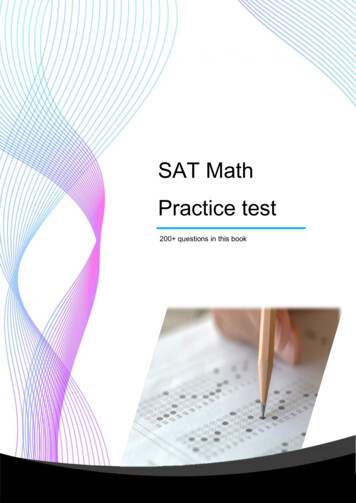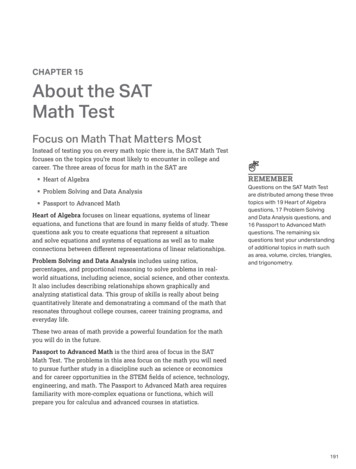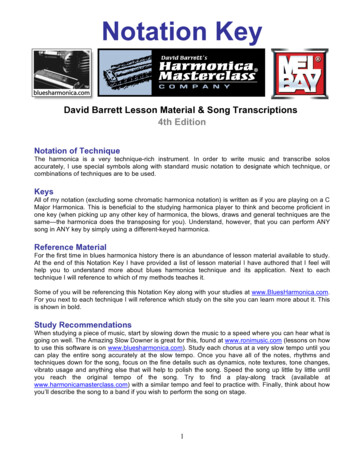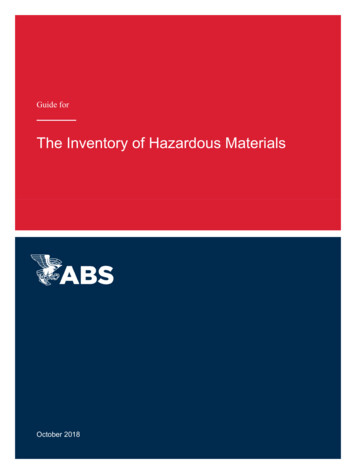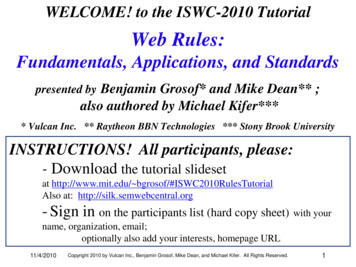
Transcription
WELCOME! to the ISWC-2010 TutorialWeb Rules:Fundamentals, Applications, and Standardspresented by Benjamin Grosof* and Mike Dean** ;also authored by Michael Kifer**** Vulcan Inc. ** Raytheon BBN Technologies *** Stony Brook UniversityINSTRUCTIONS! All participants, please:- Download the tutorial slidesetat http://www.mit.edu/ bgrosof/#ISWC2010RulesTutorialAlso at: http://silk.semwebcentral.org- Sign in on the participants list (hard copy sheet) with yourname, organization, email;optionally also add your interests, homepage URL11/4/2010Copyright 2010 by Vulcan Inc., Benjamin Grosof, Mike Dean, and Michael Kifer. All Rights Reserved.1
Top-Level Outline of TutorialA. Introduction, Overview, and UsesB. Concepts and FoundationsC. Conclusions and Directions Appendix: References and ResourcesBackground Assumed: basic knowledge of first-order logic, relationaldatabases, XML, RDF11/4/2010Copyright 2010 by Vulcan Inc., Benjamin Grosof, Mike Dean, and Michael Kifer. All Rights Reserved.2
Outline of Part A. Intro & Uses1.2.3.Overview of tutorial, and get acquaintedWhat are: Rules on the Web, Semantic Rules/Web/TechUses and Kinds of rules Commercial, web. Current, envisioned. Requirements. Business value, IT lifecycle. Strategic roadmapping of future adoption4. Example Use Cases E-commerce: pricing, ordering policies, contracts E-science: ecological process, mechanics context Trust: compliance, policies, e.g. financial services Info integration, ontology mapping, business reporting Processes: policy-based workflow, causal action effects,Semantic Web ServicesNB: (2.)-(4.) are interleaved.11/4/2010Copyright 2010 by Vulcan Inc., Benjamin Grosof, Mike Dean, and Michael Kifer. All Rights Reserved.3
Outline of Part B. Concepts & Foundations1.2.3.4.5.6.7.8.9.Overview of Logical Knowledge Representations Logic Programs (LP) and its relationship to First Order Logic (FOL) Rule-based Ontologies: Description Logic, Description LPSILK‟s Hyper LP: Putting it all togetherBasics: Horn Case; FunctionsF-Logic, Frame Syntax, Object Oriented StyleHiLog, Higher-Order Syntax, Reification, Meta-ReasoningW3C Rule Interchange Format (RIF): Dialects, Framework Rules in W3C Web Ontology Language (OWL-RL); via RIFNonmonotonic LP: Defaults, Negation, Priorities, FOL Interchange Semantics for Default Negation Courteous LP, Argumentation Theories Omni-directional Rules, FOL-Soundness, Remedying FOL‟s FragilityProcedural Attachments to Actions, Queries, Built-ins, and Events Production/Situated LP, Production RulesAdditional Features: Integrity Constraints, Inheritance, Lloyd-Topor,Equality, Skolemization, Aggregation, Datatypes, “Constraints”11/4/2010Copyright 2010 by Vulcan Inc., Benjamin Grosof, Mike Dean, and Michael Kifer. All Rights Reserved.4
Outline of Part C. Conclusions & Directions1. More about Tools2. incl. SILK3. Conclusions4. Directions for Future researchAppendix: References and Resources(General Discussion)11/4/2010Copyright 2010 by Vulcan Inc., Benjamin Grosof, Mike Dean, and Michael Kifer. All Rights Reserved.5
Rough Schedule, Overall 14:00-14:30 Part A: Intro & Uses 14:30-15:45 Part B: Concepts & Foundations 15:45-16:15 Coffee Break 16:15-17:40 Part B, continued: Concepts & Foundations 17:40-18:00 Part C: Conclusions & Directions11/4/2010Copyright 2010 by Vulcan Inc., Benjamin Grosof, Mike Dean, and Michael Kifer. All Rights Reserved.6
PART A. SLIDESFOLLOW11/4/2010Copyright 2010 by Vulcan Inc., Benjamin Grosof, Mike Dean, and Michael Kifer. All Rights Reserved.7
Outline of Part A. Intro & Uses1.2.3.Overview of tutorial, and get acquaintedWhat are: Rules on the Web, Semantic Rules/Web/TechUses and Kinds of rules Commercial, web. Current, envisioned. Requirements. Business value, IT lifecycle. Strategic roadmapping of future adoption4. Example Use Cases E-commerce: pricing, ordering policies, contracts E-science: ecological process, mechanics context Trust: compliance, policies, e.g. financial services Info integration, ontology mapping, business reporting Processes: policy-based workflow, causal action effects,Semantic Web ServicesNB: (2.)-(4.) are interleaved.11/4/2010Copyright 2010 by Vulcan Inc., Benjamin Grosof, Mike Dean, and Michael Kifer. All Rights Reserved.8
Learning Goals for Tutorial1. Overview of current state of logical KR theory,applications, languages, standards, tools/systems,market2. Relationship to Web and Semantic Tech, overall3. Introduction to the research issues11/4/2010Copyright 2010 by Vulcan Inc., Benjamin Grosof, Mike Dean, and Michael Kifer. All Rights Reserved.9
“Semantic” Technology “Semantic” in “semantic web” and “semanticrules” means:– 1. Knowledge-based and – 2. Having meaning independent of algorithm andimplementation– Equipped with an interoperable conceptual abstraction based on declarative knowledge representation (KR) Shared principles of what inferences are sanctionedfrom a given set of premisesCopyright 2010 by Vulcan Inc., Benjamin Grosof, Mike Dean, and Michael Kifer. All Rights Reserved.10
What are Rules on the Web Convergence of three streams is well along the way1.Using Web for interchange of rules, even pre-Web legacy kinds 2.XML syntax for rules. Transcend organizational silos.Rules working in Web context, using: 3.Web data, schemas, ontologies; Web services, queries, databasesRules using semantic knowledge representation (KR) Semantics are required for effective sharing of knowledge and tools Web as scope for rule-based structured knowledge––– Enrich the Web as a knowledge platform – public and intranetsCollaborative knowledge acquisition (KA), e.g., Wiki‟sWeb-located knowledge bases (KBs) and KR servicesSemantic rules on the Web–Standardization is a key activity currently. 1st wave just completed.11/4/2010Copyright 2010 by Vulcan Inc., Benjamin Grosof, Mike Dean, and Michael Kifer. All Rights Reserved.11
Semantic Web in context of Webhazy still: Semantic Web ServicesSemantic Web techniquesWeb Services techniquesAPIs on WebAutomated KnowledgeBases(WSDL/SOAP, REST)Rules (RuleML, RIF)Ontologies (OWL, RDFS)XMLDatabases (SQL, SPARQL)Two interwoven aspects: Program: Web Services Data: Semantic WebFirst GenerationWeb11/4/2010Copyright 2010 by Vulcan Inc., Benjamin Grosof, Mike Dean, and Michael Kifer. All Rights Reserved.12
Semantic Web: concept, approach, pieces Shared semantics when interchanging dataknowledge Knowledge Representation (cf. AI, DB) as approach to semantics– Standardize KR syntax, with KR theory/techniques as backing Web-exposed Databases: relational and XML/RDF data/queries– Challenge: share database schemas via meta-data– RDF “Resource Description Framework” W3C standard Ontology formally defined vocabulary– OWL: “Web Ontology Language” W3C standard Taxonomic class/property hierarchy, property-value restrictions, decidable subset of FOL– Ex.: Lions are a subcategory within felines– Ex.: Every health care visit has a required copayment amountRules if-then logical implications, facts subsumes relational DBs– RIF:“Rule Interchange Format” W3C standard Based on Logic Programs (LP) Knowledge Representation Based on RuleML (Rule Markup & Modeling Language) standards design Production rule languages– Ex.: Any student who has abused printing privileges is prohibited from using color printers– Ex.: AAA members get a weekend discount of 20% on suites, at hotel chain X– Ex.: During the mitosis phase of an animal cell’s lifecycle, all DNA is replicated11/4/201013Copyright 2010 by Vulcan Inc., Benjamin Grosof, Mike Dean, and Michael Kifer. All Rights Reserved.13
Flavors of Rules Commercially MostImportant today in E-Business E.g., in OO applications, DBs, workflows. Relational databases, SQL: Views, queries, facts are all rules. SQL99 even has recursive rules. Production rules (OPS5 heritage): e.g.,– Jess, ILOG, Blaze, Haley: rule-based Java/C objects. Event-Condition-Action rules (loose family), cf.:– business process automation / workflow tools.– active databases; publish-subscribe. Prolog. “logic programs” as a full programming language. Lesser: other knowledge-based systems. Emerging: Semantic-based technologyAbove are “Currently Commercially Important (CCI)”11/4/2010Copyright 2010 by Vulcan Inc., Benjamin Grosof, Mike Dean, and Michael Kifer. All Rights Reserved.14
Commercial Applications of Rulestoday in E-Business There are many. An established area since the 1980‟s.– Expert systems, policy management, workflow, systemsmanagement, financial & insurance, e-commerce, trust,personal messaging, defense intelligence, .– Far more applications to date than of Description Logic. Advantages in systems specification, maintenance, integration. Market momentum: moderately fast growing––––Fast in early-mid 1980‟s.Slow late 1980‟s-mid-1990‟s.Picked up again in late 1990‟s. (Embeddable methodologies.)Accelerating in 2000‟s.11/4/2010Copyright 2010 by Vulcan Inc., Benjamin Grosof, Mike Dean, and Michael Kifer. All Rights Reserved.15
Vision: Uses of Rules in E-Business Rules are an important aspect of coming world of Internet e-business:rule-based business policies & business processes, for B2B & B2C.– represent seller‟s offerings of products & services, capabilities, bids;map offerings from multiple suppliers to common catalog.– represent buyer‟s requests, interests, bids;matchmaking.– represent sales help, customer help, procurement, authorization/trust,brokering, workflow.– high level of conceptual abstraction; easier for non-programmers tounderstand, specify, dynamically modify & merge.– executable but can treat as data, separate from code potentially ubiquitous; already widely used: e.g., SQL views,queries. Rules in communicating applications, e.g., embedded intelligent agents.11/4/2010Copyright 2010 by Vulcan Inc., Benjamin Grosof, Mike Dean, and Michael Kifer. All Rights Reserved.16
Semantic Rules: Differences from Rules inthe 1980’s / Expert Systems Era Get the KR right––––––(knowledge representation)More mature research understandingSemantics independent of algorithm/implementationCleaner; avoid general programming/scripting language capabilitiesHighly scaleable performance; better algorithms; choice for interoperabilityHighly modular wrt updating; use prioritization Highly dynamic, scaleable rulebase authoring: distributed, integration, partnering Leverage Web, esp. XML– Interoperable syntax– Merge knowledge bases Embeddable– Into mainstream software development environments (Java, C , C#); not its ownprogramming language/system (cf. Prolog) Knowledge Sharing: intra- or inter- enterprise Broader set of Applications11/4/2010Copyright 2010 by Vulcan Inc., Benjamin Grosof, Mike Dean, and Michael Kifer. All Rights Reserved.17
Value of Rules as form of KR Rules as a form of KR (knowledge representation) areespecially useful– relatively mature from basic research viewpoint– good for prescriptive specifications (vs. descriptive) a restricted programming mechanism– integrate well into commercially mainstreamsoftware engineering, e.g., OO and DB easily embeddable; familiar vendors interested already: Webizing, application development tools Identified as part of mission of the W3C SemanticWeb Activity, in about 200111/4/2010Copyright 2010 by Vulcan Inc., Benjamin Grosof, Mike Dean, and Michael Kifer. All Rights Reserved.18
Declarative Logic Programs (LP) is the Core KRin today’s world including the Semantic Web LP is the core KR of structured knowledge management today Databases Relational, semi-structured, RDF, XML, object-oriented SQL, SPARQL, XQuery Each fact, query, and view is essentially a rule Semantic Rules Rule Interchange Format (RIF): -BLD, -Core RuleML standards design, including SWRL Semantic Ontologies RDF(S) OWL-RL ( the Rules subset). E.g., Oracle’s implementation of OWL. The Semantic Web today is mainly based on LP KR and thus essentially equivalent to semantic rules You might not have realized that!11/4/201011/4/2010Copyright 2010 by Vulcan Inc., Benjamin Grosof, Mike Dean, and Michael Kifer. All Rights Reserved.19
08-2005 W3C Semantic Web “Stack”: Standardization StepsCandidate design:RuleML Rule Markup &Modeling LanguageDLP DescriptionLogicPrograms11/4/2010 RuleMLCopyright 2010 by Vulcan Inc., Benjamin Grosof, Mike Dean, and Michael Kifer. All Rights Reserved.Modification of slide by W3C (just added annotation)20
Updated: 10-2010 Semantic Web “Stack”RIF Rule InterchangeFormat (W3C)BLD Basic Logic DialectCandidate designsfor Rule extensions:SILK, ASP, FOLFLDFLD Framework for Logic DialectsRL Rule Profile Horn FOL expressibleHorn LP expressible(i.e., DLP )E.g., axiomatize via 70 RIF-BLD rulesRIFBLDOWL RL2111/4/2010Modified from slide by W3C (just added annotation)
Overview of Key Languages & Standards1.2.3.4.5.6.7.Database Queries & Facts are Rules SQL; W3C SPARQL & RDF, also XQuery & XML-SchemaW3C Rule Interchange Format (RIF) -BLD, -Core: Basic LP (no defaults or actions) -FLD: Framework for extensions (defaults & much more) -PRD: Production rules (lacks model-theoretic semantics)RIF Precursor: Rule Markup/Modeling Language (RuleML) Main focus is LP, with extensions; FOL too SWRL function-free Horn; predecessor to RIF-BLD SWSL for Web Services modeling; related: WSMLRules in and for ontologies and ontology languages W3C OWL-RL, RDF SchemaSILK: Hyper Logic Programs – advanced expressivenessISO Common Logic (successor to KIF): FOL (with HiLog)OMG Sem. of Business Vocabulary & Business Rules (SBVR)11/4/2010Copyright 2010 by Vulcan Inc., Benjamin Grosof, Mike Dean, and Michael Kifer. All Rights Reserved.22
Overview of Key Tools1. Rule systems designed to work with RDF/OWL/RIF Commercial-world: Jena; Oracle; IBM; others Research-world: SILK; SweetRules; cwm; others2. Prolog and Production Rule systems XSB; Jess; others3. Advanced Expressiveness FLORA-2 and SILK; IBM CommonRules4. Rules in Semantic Wikis Semantic MediaWiki 5. Some Available Large Rule Bases OpenCyc, Process Handbook, OpenMind11/4/2010Copyright 2010 by Vulcan Inc., Benjamin Grosof, Mike Dean, and Michael Kifer. All Rights Reserved.23
Need for Other Kinds of Ontologies besides OWL Forms of ontologies practically/commercially important in the world today*:– SQL DB schemas– “Conceptual models” in UML and E-R (Entity-Relationship)– OO inheritance hierarchies, procedural interfaces, datatype declarations– XML Schema– OWL is still emerging, wrt deployed usage – dwarfed by all the above– RIF – early emerging– LP/FOL/BRMS predicate/function signatures– Builtins (e.g., SWRL/RuleML)– Equations and conversion-mapping functionsOverall relationship of OWL to the others is as yet largely unclear– There are efforts on some aspects, incl. UML.– Bright spot is OWL-RL relationship to RIF: formulated as a set of RIF-BLD axioms.OWL cannot represent the nonmon aspects of OO inheritanceOWL does not yet represent, except quite awkwardly:– n-ary relations– ordering (sequencing) aspects of XML Schema(*NB: Omitted here are statistically flavored ontologies that result from inductive learning and/ornatural language analysis.)11/4/2010Copyright 2010 by Vulcan Inc., Benjamin Grosof, Mike Dean, and Michael Kifer. All Rights Reserved.24
Outline of Part A. Intro & Uses1.2.3.Overview of tutorial, and get acquaintedWhat are: Rules on the Web, Semantic Rules/Web/TechUses and Kinds of rules Commercial, web. Current, envisioned. Requirements. Business value, IT lifecycle. Strategic roadmapping of future adoption4. Example Use Cases E-commerce: pricing, ordering policies, contracts E-science: ecological process, mechanics context Trust: compliance, policies, e.g. financial services Info integration, ontology mapping, business reporting Processes: policy-based workflow, causal action effects,Semantic Web ServicesNB: (2.)-(4.) are interleaved.11/4/2010Copyright 2010 by Vulcan Inc., Benjamin Grosof, Mike Dean, and Michael Kifer. All Rights Reserved.25
EECOMS Example of Conflicting Rules:Ordering Lead Time Vendor‟s rules that prescribe how buyer must place or modify an order:A) 14 days ahead if the buyer is a qualified customer.B) 30 days ahead if the ordered item is a minor part.C) 2 days ahead if the ordered item‟s item-type is backlogged at the vendor,the order is a modification to reduce the quantity of the item, and the buyer is aqualified customer.D) 45 days ahead if the buyer is a walk-in customer.Suppose more than one of the above applies to the current order? Conflict!Helpful Approach: precedence between the rules.– E.g., D is a catch-case: A D , B D , C DOften only partial order of precedence is justified.– E.g., C A , but no precedence wrt B vs. A, nor wrt C vs. B.11/4/2010Copyright 2010 by Vulcan Inc., Benjamin Grosof, Mike Dean, and Michael Kifer. All Rights Reserved.26
Ordering Lead Time Example in LP withCourteous Defaults@prefCust orderModifNotice(?Order,14days) :preferredCustomerOf(?Buyer,SupplierCo), purchaseOrder(?Order,?Buyer,SellerCo) ;@smallStuff orderModifNotice(?Order,30days) :minorPart(?Buyer,?Seller,?Order), purchaseOrder(?Order,?Buyer,SupplierCo) ;@reduceTight orderModifNotice(?Order,2days) :preferredCustomerOf(?Buyer,SupplierCo) andorderModifType(?Order,reduce) andorderItemIsInBacklog(?Order) andpurchaseOrder(?Order,?Buyer,SupplierCo) ;silk:overrides(reduceTight, prefCust) ; // reduceTight has higher priority than prefCust// The below exclusion constraint specifies that orderModifNotice is unique, for a given order.silk:opposes(orderModifNotice(?Order,?X), orderModifNotice(?Order,?Y)) :- ?X ! ?Y ; Rule D, and prioritization about it, were omitted above for sake of brevity.Above rules are represented in Logic Programs KR, using the Courteous defaults featureNotation:– “:-” means “if”. “@ ” declares a rule tag. “?” prefixes a logical variable.“overrides” predicate specifies prioritization ordering.An exclusion constraint specifies what constitutes a conflict .“! ” means . “silk:” is a namespace prefix.11/4/2010Copyright 2010 by Vulcan Inc., Benjamin Grosof, Mike Dean, and Michael Kifer. All Rights Reserved.27
EECOMS Supply Chain:Early Commercial Implementation & Piloting EECOMS agile supply chain collaborationindustry consortium including Boeing, Baan,TRW, Vitria, IBM, universities, small companies– 29Million 1998-2000; 50% funded by NIST ATP– application piloted IBM CommonRules and earlyapproaches which led to SweetDeal, RuleML,SweetRules, RIF, and SILK contracting & negotiation; authorization & trust11/4/2010Copyright 2010 by Vulcan Inc., Benjamin Grosof, Mike Dean, and Michael Kifer. All Rights Reserved.28
Example: E-Commerce PricingOffer from SupplierCo to Buyer@usualPrice price(per unit, ?PO, 60) :purchaseOrder(?PO, supplierCo, ?AnyBuyer) andquantity ordered( ?PO, ?Q) and (?Qshipping date(?PO, ?D) and (?D5) and (?Q1000) and“2000-04-24”) and (?D“2000-05-12”) ;@volumeDiscount price(per unit, ?PO, 51) :purchaseOrder(?PO, supplierCo, ?AnyBuyer) andquantity ordered( ?PO, ?Q) and (?Q100) and (?Q1000) andshipping date(?PO, ?D) and (?D “2000-04-28”) and (?D “2000-05-12”) ;silk:overrides(volumeDiscount , usualPrice) ; // volumeDiscount rule has higher priority// The below exclusion constraint says the value of price is unique for a given POsilk:opposes(price(per unit, ?PO, ?X), price(per unit, ?PO, ?Y)) :- ?X ! ?Y ;. Notation:“@foo” is an annotation preamble to a rule that specifies the rule‟s tag. “?” prefixes a logical variable.The “overrides” predicate specifies prioritization ordering.An exclusion constraint specifies what constitutes a conflict .“! ”means . “silk:” is a namespace prefix.11/4/2010Copyright 2010 by Vulcan Inc., Benjamin Grosof, Mike Dean, and Michael Kifer. All Rights Reserved.29
Pricing Example --XML Encoding of Rules in RuleML rulebase imp rlab usualPrice /rlab head cslit opr rel price /rel /opr ind per unit /ind var PO /var ind 60 /ind /cslit /head body (see next page, if included) /imp /rulebase / body NB: This uses an older version of RuleML markup syntax. RIF syntax is similar, butRIF Basic Logic Dialect cannot express defaults.11/4/2010Copyright 2010 by Vulcan Inc., Benjamin Grosof, Mike Dean, and Michael Kifer. All Rights Reserved.30
Ecology Ex. of Causal Process Reasoning (in SILK)/* Toxic discharge into a river causes fish die-off. *//* Init. facts, and an “exclusion” constraint that fish count has a unique value out,400); / * 1st argument of fishCount is an integer time */silk:opposes(fishCount(?s,?r,?f,?C1), fishCount(?s,?r,?f,?C2)) :- ?C1 ! ?C2;/* Action/event description that specifies causal change, i.e., effect on next state */@tdf1 fishCount(?s 1,?r,?f,0) :- occurs(?s,discharge,?r) and occupies(?f,?r);/* Persistence (“frame”) axiom */@pefc1 fishCount(?s 1,?r,?f,?p) :- fishCount(?s,?r,?f,?p);/* Action effect axiom has higher priority than persistence axiom */silk:overrides(tdf1,pefc1);/* An action instance occurs */@UhOh occurs(1,toxicDischarge,Squamish);As desired: sh,trout,0);Notes: @ declares a rule tag. ? prefixes a variable. :- means if. ! means . opposes indicatesan exclusion constraint between two literals, which means “it’s a conflict if”.11/4/2010Copyright 2010 by Vulcan Inc., Benjamin Grosof, Mike Dean, and Michael Kifer. All Rights Reserved.31
E-Commerce Ex. of Causal Process Reasoning (in SILK)/* E-commerce delivery logistics. *//* Initial fact, and prevention constraint that location is unique */loc(0,PlasmaTV46,WH LasVegasNV);silk:opposes(loc(?s,?item,?posn1), loc(?s,?item,?posn2)) :- ?posn1 ! ?posn2;/* Action/event description that specifies causal change, i.e., effect on next state */@mov1 loc(?s 1,?item,?addr) and neg loc(?s 1,?item,?warehouse):- shipment(?s,?item,?warehouse,?addr) and loc(?s,?item,?warehouse);/* Persistence (“frame”) axioms about location */@peloc1 loc(?s 1,?item,?posn) :- loc(?s,?item,?posn);/* Action effect axiom has higher priority than the persistence axioms peloc2);/* An action instance occurs */@de7 shipment(1, PlasmaTV46, WH LasVegasNV, 9 Fog St SeattleWA);As desired:11/4/2010 loc(2, PlasmaTV46, 9 Fog St SeattleWA);loc(2, PlasmaTV46, WH LasVegasNV);Copyright 2010 by Vulcan Inc., Benjamin Grosof, Mike Dean, and Michael Kifer. All Rights Reserved.32
Trust Mgmt. Ex. of Higher-Order Defaults (in SILK)illustrating also basic Knowledge-level Communication, and Frame syntaxIn Frame syntax: subject[property - object] stands for property(subject,object)./* Trust policy administration by multiple agents, about user permissions *//* Admin. Bob controls printing privileges including revocation (neg). */Bob[controls - print]; Bob[controls - neg print]; /* neg print means it is disallowed.*/Cara[controls - ?priv]; /* Cara is the most senior admin., so controls all privileges. *//* If an administrator controls a privilege and states at a time (t) that a user has a privilege,then the user is granted that privilege. Observe that ?priv is a higher-order variable. */@grant(?t) ?priv(?user) :- ?admin[states(?t) - ?priv(?user)] and ?admin[controls(?priv)];/* More recent statements have higher priority, in case of conflict. */silk:overrides(grant(?t2), grant(?t1)) :- ?t2 ?t1;/* Admins Bob and Cara make conflicting statements over time about Ann’s printing */Cara[states(2007) - print(Ann)]; Cara[states(2007) - webPage(Ann)];Bob[states(2008) - neg print(Ann)];As desired: neg print(Ann); webPage(Ann);/* Currently, Ann is permitted a webpage but not to print. */Notes: @[ ] declares a rule tag. ? prefixes a variable. :- means if. ! means . neg is strong negation.There is an implicit exclusion (silk:opposes) between P and neg P, for every literal P.11/4/2010Copyright 2010 by Vulcan Inc., Benjamin Grosof, Mike Dean, and Michael Kifer. All Rights Reserved.33
Physics Ex. of Contextual Assumptions (in SILK)/* “P8: Joe drops a glove from the top of a 100m cliff.How long does the fall take in seconds?” */// Initial problem-specific factsAP problem(P8); fall event(P8); P8[height- 100];// Action description that specifies causal implications on the continuous process?e[time- ((2 * ?h / ?n) 0.5)] :- fall event(?e) and ?e[height- ?h, net accel- ?n];?e[net accel- (?g - ?a)] :- fall event(?e) and?e[gravity accel- ?g, air resistance accel- ?a];// Other facts?e[gravity accel- 9.8] :- loc(?e, Earth);?e[gravity accel- 3.7] :- loc(?e, Mars);// Contextual assumptions for answering Advanced Placement exam (AP) problems@implicit assumption loc(?e, Earth) :- AP problem(?e);silk:opposes(loc(?e, Earth), loc(?e, Mars));@implicit assumption ?e[air resistance accel- 0] :- AP problem(?e);silk:overrides(explicitly stated, implicit assumption);As desired:11/4/2010 P8[net accel- 9.8, time- 4.52];// 4.52 (2*100/9.8) 0.5Copyright 2010 by Vulcan Inc., Benjamin Grosof, Mike Dean, and Michael Kifer. All Rights Reserved.34
Physics Ex. of Contextual Assumptions (in SILK)/* “P8: Joe drops a glove from the top of a 100m cliff on Mars.How long does the fall take in seconds?” *//* Initial problem-specific facts*/AP problem(P8); fall event(P8); P8[height- 100];@explicitly stated loc(P8,Mars); As desired:11/4/2010 P8[net accel- 3.7, time- 7.35]; // 7.35 (2*100/3.7) 0.5];Copyright 2010 by Vulcan Inc., Benjamin Grosof, Mike Dean, and Michael Kifer. All Rights Reserved.35
Outline of Part A. Intro & Uses1.2.3.Overview of tutorial, and get acquaintedWhat are: Rules on the Web, Semantic Rules/Web/TechUses and Kinds of rules Commercial, web. Current, envisioned. Requirements. Business value, IT lifecycle. Strategic roadmapping of future adoption4. Example Use Cases E-commerce: pricing, ordering policies, contracts E-science: ecological process, mechanics context Trust: compliance, policies, e.g. financial services Info integration, ontology mapping, business reporting Processes: policy-based workflow, causal action effects,Semantic Web ServicesNB: (2.)-(4.) are interleaved.11/4/2010Copyright 2010 by Vulcan Inc., Benjamin Grosof, Mike Dean, and Michael Kifer. All Rights Reserved.36
Challenge: Capturing Semanticsaround Policies Deep challenge is to capture the semantics of dataand processes:– To represent, monitor, and enforce policies –e.g., trust and contracts– To map between definitions of policy entities,e.g., in financial reporting– To integrate policy-relevant informationpowerfully11/4/2010Copyright 2010 by Vulcan Inc., Benjamin Grosof, Mike Dean, and Michael Kifer. All Rights Reserved.37
Policies for Compliance and Trust Mgmt.:Role for Semantic Web Rules Trust Policies usually well represented as rules– Enforcement of policies via rule inferencing engine– E.g., Role-based Access Control This is the most frequent kind of trust policy in practical deployment today.– W3C P3P privacy standard, OASIS XACML, XML accesscontrol emerging standard, Ditto for Many Business Policies beyond trust arena, too– “Gray” areas about whether a policy is about trust vs. not:compliance, regulation, risk management, contracts, governance,pricing, CRM, SCM, etc.– Often, authorization/trust policy is really a part of overall contractor business policy, at application-level. Unlike authentication.– Valuable to reuse policy infrastructure11/4/2010Copyright 2010 by Vulcan Inc., Benjamin Grosof, Mike Dean, and Michael Kifer. All Rights Reserved.38
Trust Policies and Compliance inUS Financial Industry Today Ubiquitous high-stakes Regulatory Compliancerequirements– Sarbanes Oxley, SEC (also in medical domain: HIPAA), etc. Internal company policies about access, confidentiality,transactions– For security, risk management, business processes, governance Complexities guiding who can do what on certain business data Often implemented using rule techniques Often misunderstood or poorly implemented leading to vulnerabilities Typically embedded redundantly in legacy silo applications, requiringhigh maintenance Policy/Rule engines lack interoperability11/4/2010Copyright 2010 by Vulcan Inc., Benjamin Grosof, Mike Dean, and Michael Kifer. All Rights Reserved.39
Example Financial Authorization RulesClassificationApplicationRuleMerchantPurchase ApprovalIf credit card has fraud reported onit, or is over limit, do not approve.Mutual FundsRep trading“Blue Sky:” State restrictions forrep‟s customers.Mortgage CompanyCredit ApplicationTRW upon receiving creditapplication must have a way ofsecurely identifying the request.BrokerageMargin tradingMust compute current balances andmargin rules before allowing trade.InsuranceFile ClaimsPolicy States and Policy type mustmatch for claims to be processed.BankOnline BankingUser can look at own account.AllHouseholdingFor purposes of silo (e.g.,statements or discounts), aggregateaccounts of all family members.11/4/2010Copyright 2010 by Vulcan Inc., Benjamin Grosof, Mike Dean, and Michael Kifer. All Rights Reserved.Slide also by Chitravanu Neogy40
Verticals that appear good candidates forEarly Adoption of SW Rules for Privacy Financial– Cf. discussion earlier in this talk– Historically, an early adopter of information technology overall esp. forintegration– Large sector of global economy– Privacy/trust policies very important, distributed & heterogeneous Medical– Privacy/trust policies very important, distributed & heterogeneous– Expecting help on privacy from information technology– Large sector of global economy Police/Military– Privacy/trust policies very important, distributed & heterogeneous– Looking for help on privacy from information technology– Major funder of SW basic research to date, e.g., DARPA Agent MarkupLanguage program 2000-2005 In many other realms, there is a large gap between revealed vs. avowed preferencesfor value of privacy/confidentiality.11/4/2010Copyright 2010
SQL; W3C SPARQL & RDF, also XQuery & XML-Schema 2. W3C Rule Interchange Format (RIF) -BLD, -Core: Basic LP (no defaults or actions) -FLD: Framework for extensions (defaults & much more) -PRD: Production rules (lacks model-theoretic semantics) 3. RIF Precursor: Rule Markup/Modeling Language (RuleML)
